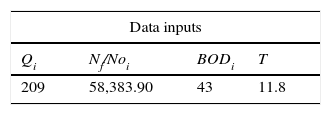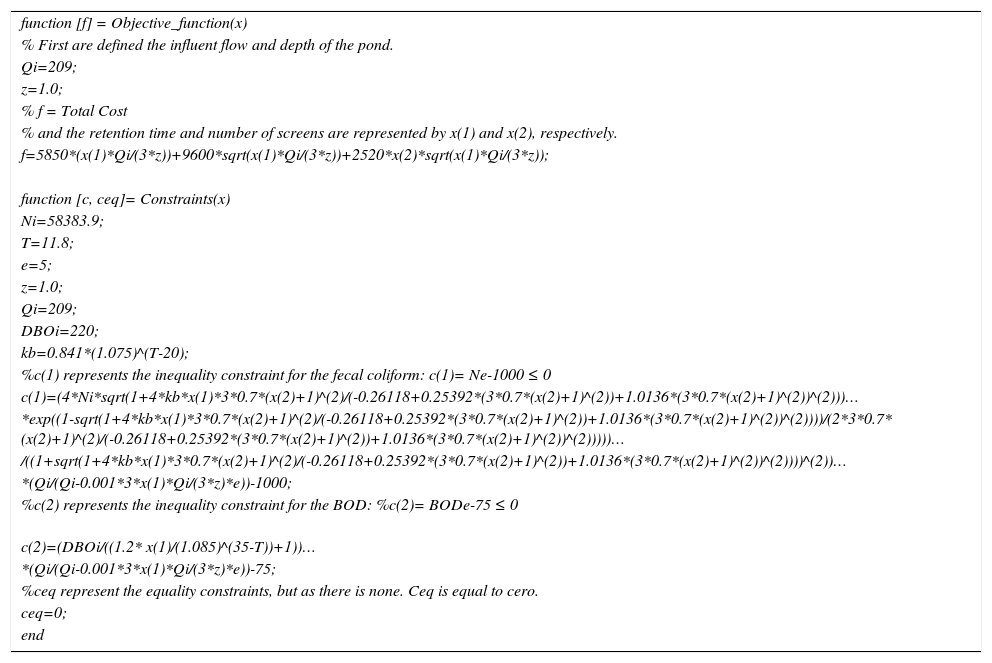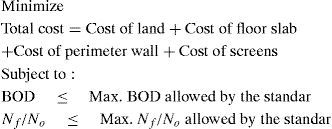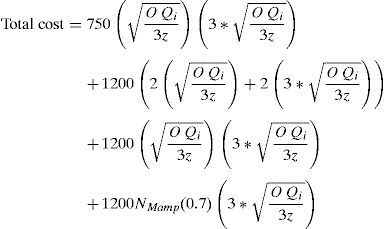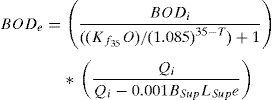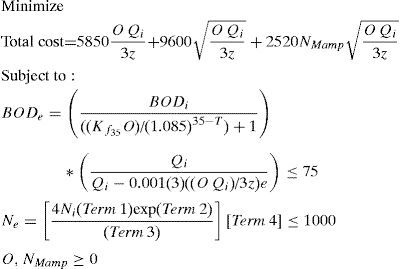Many lagoon systems in Mexico, and generally in developing countries, do not meet the norm for water pouring into receptors bodies. It was applied mathematical modeling to optimize the design and cost of a maturation pond, considering the methodology adopted for Mexico by the National Water Commission, taking as variables the hydraulic retention time and the number of screens, then the results were compared with a traditional design of a maturation pond without screens. Both analyses fulfill the treated water quality standards for pouring into receptors bodies. The results show a reduction in the hydraulic retention time by 8.65 days, and a reduction by 48.16 percent in land requirement. About the cost, it was obtained a reduction of 42.24 percent in comparison whit the traditional method. A major advantage of the mathematical model is the obtaining of the optimal design, which would be very difficult to get with the traditional methodology because the process is iterative and uses more than one variable, also can be inferred that the use of screens increases the efficiency. The algorithm used was the interior point by Matlab's Fmincon function, which determines the optimal values to accomplish the water quality constraints and obtains the lowest possible cost for construction. It is included the sensitive analysis for the mathematical model. It is recommended to carry out the present research at real scale with the finality to check the results given by the optimization.
concentration of organic matter in the system input (mg/L)
lower average air temperature (°C)
area (m2)
flow at the entrance of the lagoon system (m3/day)
depth (m)
volume (m3)
average hydraulic retention time in the polishing pond (days)
width length ratio
average width of the pond (m)
average length of the lagoon in (m)
superior width (m)
superior length (m)
pond surface area (m2)
flow at the outlet of the pond (m3/day)
evaporation (mm/day)
dimensionless dispersion factor
bacterial reduction coefficient (day−1)
dimensionless constant
fecal coliform in the pond outlet (MPN/100mL)
fecal coliform modified by evaporation in the system output (MPN/100mL)
number of fecal coliform in the output of the system (MPN/100mL)
decay constant at any temperature (day−1)
BOD5 concentration in the system output (mg/L)
modified BOD5 concentration by evaporation in the lagoon system output (mg/L).
number of baffles in the maturation lagoon
The lagoon systems are primarily aimed at the removal of organic matter, also known as biochemical oxygen demand (BOD) and elimination of fecal coliform. These treatment systems are classified into three types: anaerobic, facultative and maturation or polishing (CNA and IMTA, 2007a; Mendonca, 2000).
The main function of maturation ponds is to remove fecal coliform by ultraviolet rays and the process is carried out aerobically. According to Mendonca (2000) it is recommended, for this kind of ponds, depths of 0.5–1.2m.
The construction of these systems is inexpensive, easy to operate and the maintenance is simple. The purpose of the stabilization ponds is to retain the wastewater for a period of time, so that the wastewater is cleaned naturally (Abbas, Nasr, & Seif, 2006; Mendonca, 2000; Naddafi et al., 2009; Shilton & Mara, 2005). According to Rojas (2002) and Cubillo (1982) the application of traditional design methodologies ended in losses, as these systems usually have been overstated. It is also suggested considering in the design at least two ponds (facultative and maturation) in other words avoid designing the system with a single lagoon: facultative. On the other hand, when wastewater is discharged without complying about quality standard norms drives to health problems in a population: typhoid, paratyphoid, hepatitis and leprosy among others. A major disadvantage of these systems is that they need a considerable area of land, notwithstanding the foregoing, Naddafi et al. (2009), Hamzeh and Ponce (2007) recommended them for developing countries with tropical climates, since the temperature and intensity of the sunlight increases the efficiency in removal of contaminants.
Shilton and Harrison (2003a) suggest considering channels or screens in the design of the lagoon systems. According to these authors the model significantly improved the hydraulic conditions: is favored the piston flow and the dead zones are eliminated. Also increases the removal of pollutants.
Some authors consider screens in the design: Shilton and Mara (2005), Abbas et al. (2006), Muttamara and Puetpaiboon (1997) and Banda (2007). These authors carried out laboratory studies with different lengths of baffles: concluded that is obtained improved results with 70 percent of the total length of the pond.
Then Bracho, Lloyd, and Aldana (2006) and Winfrey, Strosnider, Nairn, and Strevett (2010) conducted more experimental tests, also considering baffles. The results showed that a greater hydraulic efficiency within the pond with a greater number of baffles.
In order to minimize the cost of construction Kilani and Ogunrombi (1984) recommended optimizing the design of the system gaps, then Bracho et al. (2006), Winfrey et al. (2010), Oke and Otun (2001) and Olukanni and Ducoste (2011) conducted studies where were considered linear models to define optimum design. It was determined that it is possible to improve the design; i.e, maximize the removal of contaminants and minimize the cost of treatment systems. Then Sah, Rousseau, and Hooijmans (2012) recommended the need to analyze an integral and calibrated model for lagoon systems so that it can be used as an optimization tool and support.
The aim of this paper was to propose and implement a comprehensive mathematical model for the optimization of a maturation pond, taking into account the fecal coliform and organic matter in accordance with the concentration limits established. The purpose of the model is to minimize construction costs and comply with quality standards of treated water.
Two analyzes will be carried out: the first considers the traditional design of the maturation pond excluding screens. In the second analysis was constructed a mathematical model for optimizing the design, considering as variables the retention time and the number of screens. It is intended to compare the economic advantages and efficiency in the elimination of contaminants between the two studies.
Another important application, of the present mathematical model, is to complement the treatment system when you have solely one pond (facultative) and the quality of the treated water does not meet the requirements indicated by the regulations for discharging into water bodies. According to Bixio et al. (2005) the maturation ponds can be added as a secondary treatment for restricted and unrestricted irrigation.
There was not founded bibliography of a mathematical model for the minimization in the construction cost for a maturation pond taking into account the water quality as constraint. The contribution of the present paper is the construction of the model mentioned above.
2Material and methods2.1Maturation pond (dispersed flow)(1) For the hydraulic retention time (O), the methodology is iterative and the way to carried out is to propose a retention time, later are determined the fecal coliform concentration and the BOD in the output of the pond. The norm indicates that the pollutants must be equal or less than 1000 MPN/100mL and 75mg/L respectively
- (a)
For determining the volume of the pond we have:
- (b)
Area of the pond:
- (c)
Width–length ratio X=3:
- (d)
For defining the superior width and length we have:
- (e)
Area of the superior water surface:
- (f)
Flow in the output of the lagoon:
- (g)
Fecal coliform decay with screens at 70 percent of the length:
- (h)
Bacterial decay coefficient:
- (i)
For “a” constant we have:
- (j)
Number of fecal coliform in the output of the pond:
- (k)
Number of fecal coliform corrected by evaporation:
- (l)
Kinetic coefficient:
- (m)
BOD concentration of the pond:
- (n)
BOD removal efficiency:
- (o)
BOD modified by evaporation:
Fig. 1 shows the operative route to perform the optimal design of a maturation pond.
Flow chart for the optimal design of a maturation pond (Martínez et al., 2014).
In order to design maturation pond must be constructed and optimization model, in which the variable to optimize is the cost of construction of the pond, this cost considers four parameters: land, concrete floor slab, perimeter wall and screens. The optimization model has to be restricted by water quality standards, in this case: BOD and fecal coliform. The purpose of the mentioned above is that the model finds the lowest cost in which the pond accomplishes the water quality standards. A simple mathematical representation is shown in formula (19):
According to the methodology indicated by CNA and IMTA (2007a), for the design is used a depth of 1.0m as seen in Fig. 2.
The next step in the construction of the optimization model is to determine how to link the constraints with the objective function (total cost); both parts of the model must depend on the same variables. These variables are called decision variables or changing variables. For the maturation pond are taken as decision variables the retention time (O) and the number of screens (NMamp).
3.1Objective functionThe cost of land was considered to be $ 750.00 per square meter; perimeter wall: $ 1200.00 per meter; cost of floor slab: $1200.00 per square meter; cost of screens: $ 1200.00 per meter. With these data the expression (20) is determined.
In the expression (20) is substituted the land area for the expressions (5) and (6) of the methodology, then the perimeters is substituted for: 2BSup+2LSup. The floor slab area is substituted by the formulas (5) and (6); and the screen length can by represented by the multiplication of the number of screens and the length, which according to the methodology is the 70 percent of the lagoon length. The expression (21) shows the substitutions:The expression (21) can by simplified by using the length: width ratio of 3. The expression (22) shows the mentioned above:In order to define the decision variables (O and NMamp); must be cleared the volume in the expression (2) and replaced by the formula (1); as seen in formula (23):
Later the expression (23) is substituted in formula (3); in this case the slope of the perimeter wall is cero, so BSup is equal to BProm and is obtained:Then the expression (24) is substituted in formula (22), as seen in expression (25):Finally the formula (24) and (25) are substituted in the objective function (21), and is obtained:The formula (26) can by simplify as shown in expression (27):3.2Model constraintFollowing the criterion used by Martínez, Cansino, García, Kalashnikov, and Rojas (2014), for determining the model's constraints of a facultative pond are taken the formulas (28) and (29):
whereThe superior width and length (formulas (24) and (25)) are substituted in the expressions (28) and (33), that is the way to link the constraints to the objective function (27); the model depends on the decision variables (O and NMamp). The above process is shown below:
Finally the optimization model is presented complete (expression (36)), the fecal coliform and the BOD are restricted by the norm NOM-001-ECOL-96. Also, it is added a non-negativity condition for the decision variables (OM, NMamp≥0).
4Example applicationIt is needed to redesign a wastewater treatment plant for a rural community of 1500 inhabitants located in the municipality of Gómez Palacio, state of Durango, MX. The last step of the treatment plant is a facultative pond, but the number of fecal coliform in the effluent does not meet the standard for pouring into receptor water bodies. It is proposed to add a maturation pond after the facultative one. In Table 1 are shown the dimensions and data outputs of the existent pond.
With the data outputs from Table 1 is designed the maturation pond using the traditional methodology, without considering screens. Table 2 shows the results.
Maturation pond design with the traditional methodology.
| Data inputs | |||
|---|---|---|---|
| Qi | Nf/Noi | BODi | T |
| 209 | 58,383.90 | 43 | 11.8 |
| Results | ||||||||
|---|---|---|---|---|---|---|---|---|
| Pond | O (days) | X | d | Kb | a | WProm (m) | LProm (m) | Average area (m2) |
| Maturation | 17.95 | 3 | 0.3118 | 0.4648 | 3.37661 | 35.35 | 106.06 | 3749.53 |
| Pond | Qe (m3/day) | Ne (MPN/100mL) | BODe (mg/L) | NMamp | WSup (m) | LSup (m) | ASup (m2) | Total cost |
| Maturation | 190.18 | 1000 | 11 | 0 | 35.35 | 106.06 | 3749.53 | $7,650,981.38 |
Fig. 3 shows the dimensions of the pond system determined with the traditional methodology, as already indicated there were no screens considered in the maturation pond. In accordance with Table 2, were obtained the fecal coliform and the BOD within the maximum pollutant allowed by norm.
4.2Mathematical model applicationIn order to solve the minimization model, it is used the interior point algorithm. The model (expression (36)) must be written in code as shown below:
| function [f] = Objective_function(x) |
| % First are defined the influent flow and depth of the pond. |
| Qi=209; |
| z=1.0; |
| % f = Total Cost |
| % and the retention time and number of screens are represented by x(1) and x(2), respectively. |
| f=5850*(x(1)*Qi/(3*z))+9600*sqrt(x(1)*Qi/(3*z))+2520*x(2)*sqrt(x(1)*Qi/(3*z)); |
| function [c, ceq]= Constraints(x) |
| Ni=58383.9; |
| T=11.8; |
| e=5; |
| z=1.0; |
| Qi=209; |
| DBOi=220; |
| kb=0.841*(1.075)^(T-20); |
| %c(1) represents the inequality constraint for the fecal coliform: c(1)= Ne-1000 ≤ 0 |
| c(1)=(4*Ni*sqrt(1+4*kb*x(1)*3*0.7*(x(2)+1)^(2)/(-0.26118+0.25392*(3*0.7*(x(2)+1)^(2))+1.0136*(3*0.7*(x(2)+1)^(2))^(2)))… |
| *exp((1-sqrt(1+4*kb*x(1)*3*0.7*(x(2)+1)^(2)/(-0.26118+0.25392*(3*0.7*(x(2)+1)^(2))+1.0136*(3*0.7*(x(2)+1)^(2))^(2))))/(2*3*0.7*(x(2)+1)^(2)/(-0.26118+0.25392*(3*0.7*(x(2)+1)^(2))+1.0136*(3*0.7*(x(2)+1)^(2))^(2)))))… |
| /((1+sqrt(1+4*kb*x(1)*3*0.7*(x(2)+1)^(2)/(-0.26118+0.25392*(3*0.7*(x(2)+1)^(2))+1.0136*(3*0.7*(x(2)+1)^(2))^(2))))^(2))… |
| *(Qi/(Qi-0.001*3*x(1)*Qi/(3*z)*e))-1000; |
| %c(2) represents the inequality constraint for the BOD: %c(2)= BODe-75 ≤ 0 |
| c(2)=(DBOi/((1.2* x(1)/(1.085)^(35-T))+1))… |
| *(Qi/(Qi-0.001*3*x(1)*Qi/(3*z)*e))-75; |
| %ceq represent the equality constraints, but as there is none. Ceq is equal to cero. |
| ceq=0; |
| end |
The model was solved by Matlab's Fmincon function, with the interior point algorithm. The model determines the variables, in this case the total cost, retention time and number of screens. The results are shown in Table 3.
Following the criteria of Fig. 1, the number of screens turned out to be a decimal number, so it is rounded to the next integer number, then NMamp=6. With this data are calculated the rest of the results with the traditional methodology, as seen in Table 4.
Optimized results.
| Data inputs | |||
|---|---|---|---|
| Qi | Nf/Noi | BODi | T |
| 231 | 10,000,000 | 220 | 11.8 |
| Results | ||||||||
|---|---|---|---|---|---|---|---|---|
| Pond | O (days) | X | d | Kb | a | WProm (m) | LProm (m) | Average area (m2) |
| Maturation | 9.30240 | 102.9 | 0.0096 | 0.4648 | 1.0795 | 25.45 | 76.36 | 1943.55 |
| Pond | Qe (m3/day) | Ne (MPN/100mL) | BODe (mg/L) | NMamp | WSup (m) | LSup (m) | ASup (m2) | Total cost |
| Maturation | 199.21 | 956.02 | 17 | 6 | 25.45 | 76.36 | 1943.55 | $4,419,115.73 |
According to Tables 2 and 4, the hydraulic retention time was reduced by 8.65 days, which represents the 48.18 percent. According to CNA and IMTA (2007a, 2007b) the above reduction affects the area of land required. It is important to mention that unlike the traditional design, which is iterative, the interior point algorithm determined the optimum retention time and number of screens, and this would be very complicated to achieve with the traditional method because it has more than one independent variable.
With the Matlab software were inferred that 6 screens would be the best, about this, Shilton and Mara (2005), Abbas et al. (2006), Shilton and Harrison (2003a), Muttamara and Puetpaiboon (1997), Bracho et al. (2006), Winfrey et al. (2010), Kilani and Ogunrombi (1984), Muttamara and Puetpaiboon (1996), Von Sperling, Chernicharo, Soares, and Zerbini (2002), Shilton and Harrison (2003b) carried out studies in stabilization ponds were different numbers of screens were considered, and They concluded that the uses of screens increases the elimination of the pathogens, also the hydraulic flow gets improved within the pond. The present paper confirms the conclusions made by these authors.
Tables 2 and 4 shows that the fecal coliform and the BOD are below the maximum contaminant allowed by norm NOM-001-ECOL-96 DOF (1996). The area in the optimized design was reduced by 1 805.98 square meters: which represents the 48.16 percent. The difference in the area is an important saving in land requirement. According to CNA and IMTA (2007a, 2007b), the major disadvantage of the ponds systems is the large area required.
The cost saving with the optimized lagoon, regard the traditional method, was 42.24 percent which represents $3,231,865.65. About this, Olukanni and Ducoste (2011) mentioned the feasibility to diminish the construction cost of a pond system as long as the constraints are defined correctly; i.e., when the mathematical model is applied all the pollutants are within the norm.
Fig. 4 shows the dimensions of the maturation pond and the number of screens for the optimization model.
4.3Sensitivity analysisAccording to Anderson, Sweeney, and Williams (1999), sensitivity analysis can be done using a tornado diagram. The aforementioned study consists of modifying the values of the main variables in order to observe how the optimum solution is affected.
The tornado diagram uses bars to define sensitivity; i.e., the widest bar indicates the most sensitive parameter on which the constraints depend on. For sensitivity analysis of fecal coliform and BOD, we established the cells on which they depend, and then their values are changed ±10 percent (Muramatsu, 2011).
Fig. 5 shows the sensitivity analysis for fecal coliform. The wide bar is the hydraulic retention time, it is interpreted that the concentration of fecal coliform increases when there is lower retention time. The second parameter that influences the fecal coliform removal is temperature: lower temperatures mean higher concentration of the indicator organism, in order of importance the tornado chart continues with the number of partitions.
Regarding sensitivity analysis for biochemical oxygen demand (Fig. 6), BOD concentration in the influent represents the most sensitive parameter. Next, in order of importance, the temperature: the lower the temperature, the pollutant removal efficiency decreases and increases the concentration of organic matter in the effluent. Finally, the hydraulic retention time is interpreted that a shorter retention time increases the concentration of organic matter in the effluent.
5ConclusionsA mathematical model was constructed to optimize the design and cost of a maturation pond. The results show a significant decrease in hydraulic retention time and cost compared to the results of the traditional system. The decision variables were considered open, i.e., the optimal variables were determined by Matlab, taking into account the water quality constraints.
The optimization results in the maturation pond indicate more efficient removal of fecal coliform with baffles. The climatic conditions in Gómez Palacio, located in Durango, Mexico, were considered in this study.
It is wise to mention that the proposed mathematical model can be adjusted and applied to different design conditions, but it is necessary to change the data to the environmental conditions prevailing in the region under study (e.g.: temperature and evaporation). Other important data are the influent flow, cost of concrete walls, cost of the land and cost of screens.
As seen in Table 4, the considerations and mathematical reasoning were verified using the decision variables defined in the optimization of the traditional design methodology. It is recommended to conduct this study in a laboratory in order to verify the results of the mathematical model.
Conflict of interestThe authors have no conflicts of interest to declare.
Peer Review under the responsibility of Universidad Nacional Autónoma de México.










